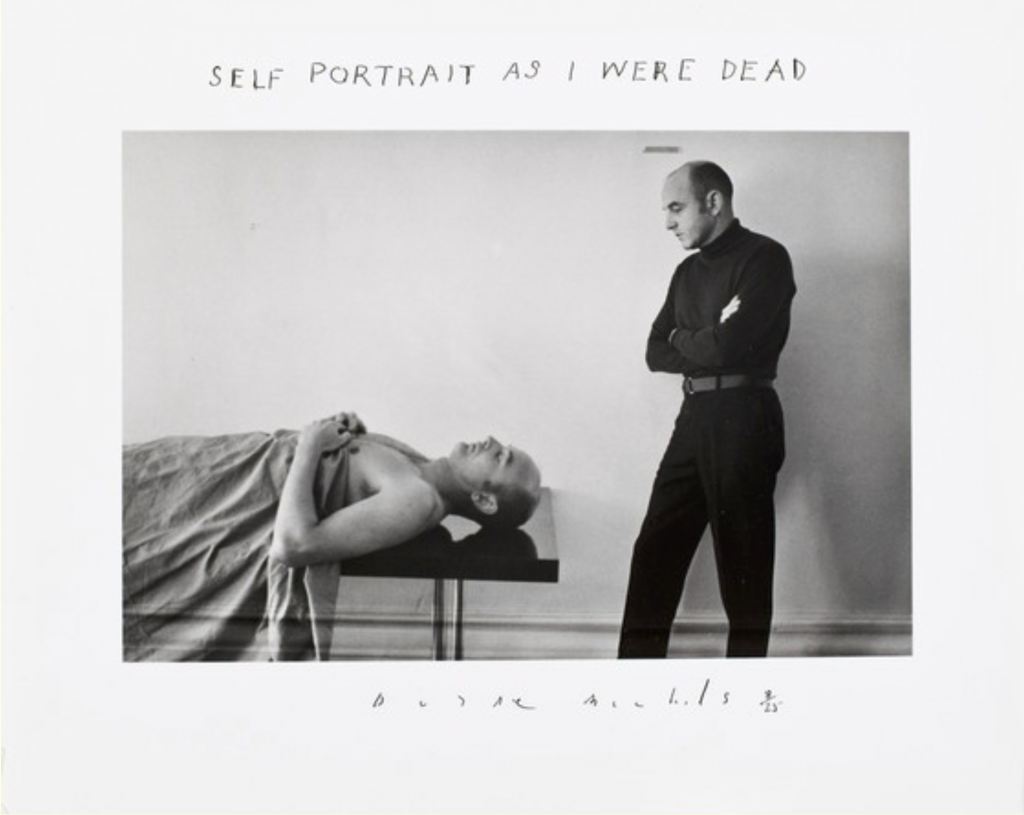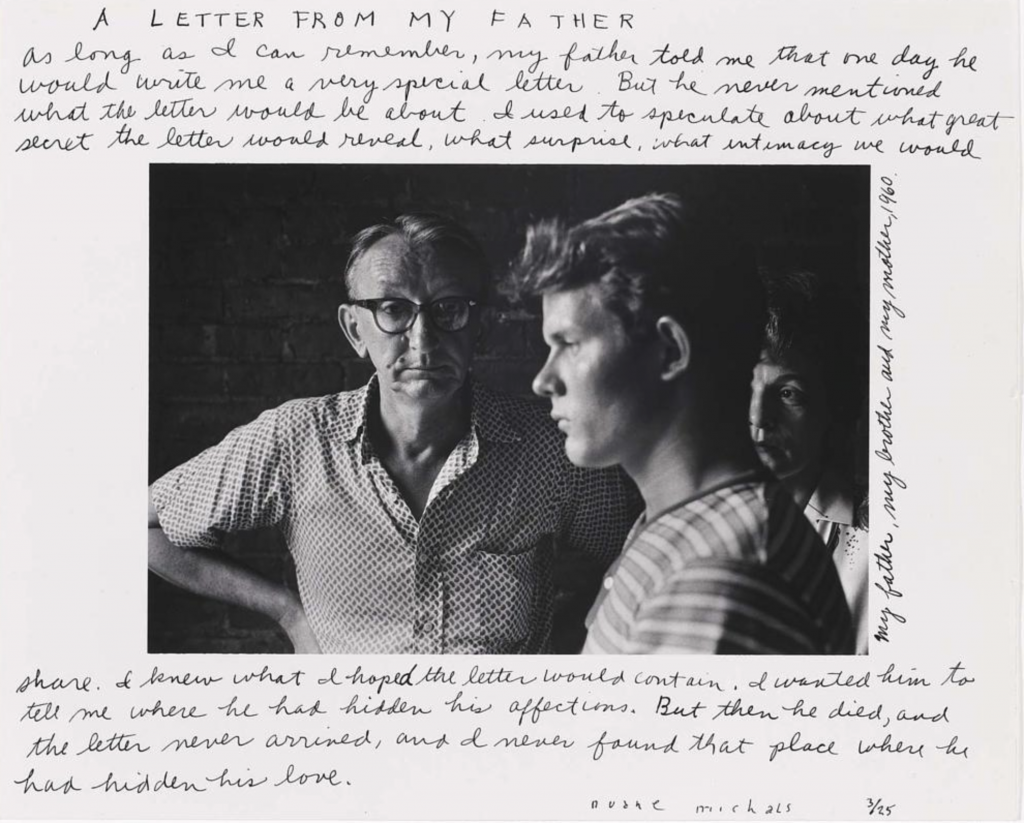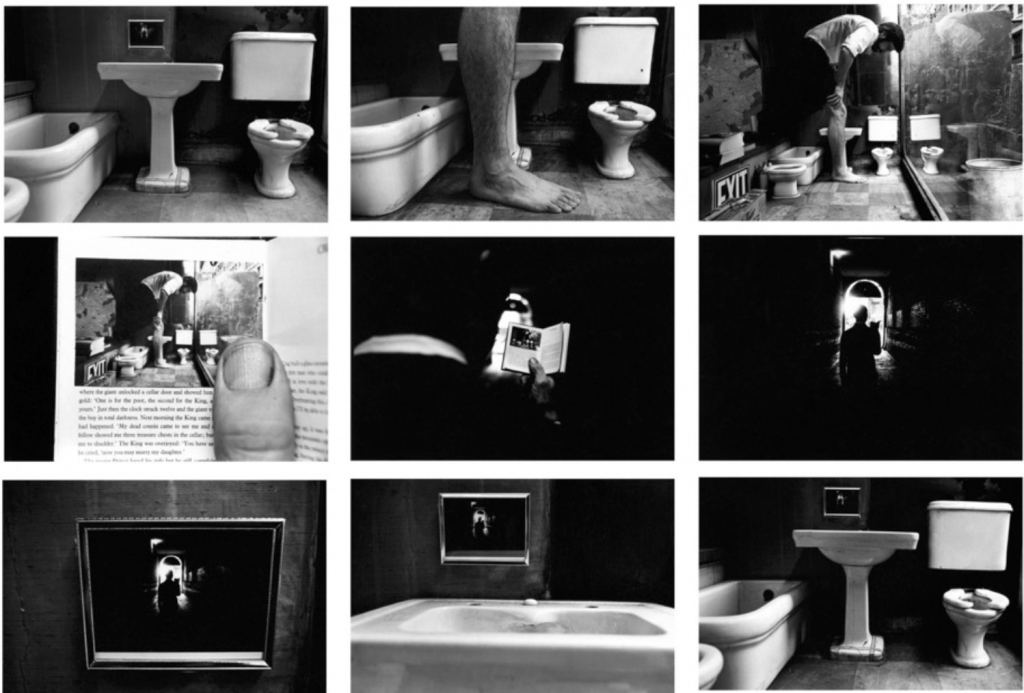For the first lecture back we met Alice in the rearranged room after some IT issues with the presentation kit. She introduced the session by sharing what we’d be doing in the coming semester. Sounds like some good stuff, including Riso Printing, Photographs As Evidence and Performing For The Camera.
This session though is around Surreal Narratives and for this we looked primarily at the work of Duane Michals
I’ve heard of his name but don’t recall much about his work until Alice showed us some of the photos and art he’d produced. First photograph we were shown was “Self portrait as if I were dead 1968.” and the question was asked of the group.

What does this photograph suggest about Michals and his work? My initial thoughts spilled onto the iPad screen as follows after considering the photograph using the analysis tools we’ve been using in semester one.
Who. Artist appears twice as if looking over his own corpse, wearing all black as if to appear like yin/yang opposite of naked skin under the creased bedsheet.
What. Artist lying corpse like on a table, under a sheet, but not a hospital table looks like a dining table.
Looking down on him with his arms crossed as if disappointed that it’s come to this. Or he hasn’t made enough of his life etc.
Where. Looks like it was at home and not in a studio
How. Double exposure as you can see the skirting through the sheet hanging down off the table.
Why. Interested in opposites, life/death, black/white, upright/horizontal. possibly a technical exercise of double exposures.
Alice also mentioned that it is unusual to hand write onto print. This additional text is an important part of Michals’ practice.
Anti-traditionalist, Uses text and says that he likes to “photographs things we cannot see”. Some themes throughout his catalogue feature homosexuality, mortality and family
“He doesn’t believe in the eyes he believes in the mind”. Linda Benedict Jones
Why is Michals important as a photographer/artist ?
Will change photography to do what he wants and thinks of himself as an artist not a photographer
Blurring, double exposure,mirror images were something he renewed. Going against the purists thinking that these effects were the result of mistakes in the process.
Created “photo-stories” in 1974 and set up narratives along with his photographs by using the accompanying text. Often the text did not relate directly to the contents of the image but added context to it, controlling how the viewer reads the image.
Didn’t follow ideas of “good”photography and thought that rules were made to be avoided so experimented with various techniques as discussed above.
Sequences?
Michals used sequences a lot in his work, do we know what a sequence actually is?
- One or number of photos where something changes over time
- A story that explains a process
- Something in order.
- Noah suggested decaying fruit Timelapse
- A particular order in which related things follow each other
- Different to a series in which order doesn’t matter as much
The definition that Alice gave us is “Related events movements or items that follow each other”
Reminiscent of frame by frame format of cinema or the storyboards that movie makers use to tell the story before it gets captured on film or digital sensor. It is successive motion
Alice then shared another of Michals’ sequences an excerpt from “The house I once called home” 2003

My initial thoughts when looking at the image:
- Three photos of a family photo
- Filling his memories of the front garden with his family
- Technically it’s two photos not one shot three times
- The stance between the 2nd and 3rd is the same so it’s not a double exposure and then a proper exposure
- Looks like the whole family is out but not all looking at the camera.
- The first looks a rundown property and then the sequence looks like the family grows into the house
- The top photo is the later image, 2nd is it mixed with an older photo, bottom is the oldest showing the family in front of a tidy house.middle image is a mixture of both negatives overlapped
- He doesn’t live there anymore, or the family doesn’t live there, maybe he still does but it doesn’t feel like home.
- Triptych that consists of three pieces of work that exist together but wouldn’t make the same story aif separated.
Talking with the group other words came up that made sense. Memory, recollections, flashback, I hadn’t noticed there was an older gent in the top image of the three but it was apparently Michal’s recreating his pose for the original photo when he was younger, outside the, then tidier, family house. In the top picture you can see it’s unkempt and the growth of the flora is untidy while in the bottom one it’s considerably more manicured. The centre image is a combination of the two wither by layering negatives, double exposing paper or digital manipulation.
Narratives
What is meant by the term narrative ?
- A story made up multiple sequence of images
- Perhaps use of text to help explain the photos
Alice then gave us a handout where Michals talks about fate and chance all resulting in Andy’s photo. (The bottom family photo taken by Andy) It’s fossilised he tells us in language that is poetic, spiritual and also scientific. He has handwritten the text also, as is usual for him and this connects us directly to the writer, rather than it being typewritten or printed.
Next up was another photograph from Michals. “A letter from my father” from 1960
Alice removed any text written on the print so that we could interpret the photo. The Mum and Dad characters in the image look expectant as though waiting for their son to finally fly the nest or go to college. Or they even might be kicking him out due to an argument or disagreement.
Father clearly in focus whilst young man in front is out of focus but still easy to read expression which looks determined yet sad. The father has hands on hips in an aggressive stance whilst the mother is in the dark as if not very influential and takes up very little room in the image.

Michals is quoted as saying. “A photograph of my parents or my father doesn’t tell me for a second what I thought of my father, which for me is more important than what the man looks like. So then I had to evolve into writing. Not that writing actually describes what you are looking at, but to actually talk about what you can’t see.”
(http://www.dshed.net/digitised/reveal/resources/case_study_duane.html)
This is his way of saying the text on the image about a letter that his father never sent him might have contained some mysterious secret or even where his love had been hidden. The text wasn’t about the image but the people in the image. This helps us paint a picture of the subjects using triangulation of a picture, an example of the persons personality and we join them together to interpret the image as it’s intended.
Surreal
What do I think Surreal means?
Dreamlike, unusual,
The definition Alice gave us: Strange, not seeming real;like a dream
Michals was influenced by surrealism and in particular Balthasar, Magritte and de Chirico
We looked at two de Chirico Paintings from the early 20th Century and examined them for things that we noticed.

Anxious Journey, Paris, 1913
- Weird perspectives
- overly tall doorways arches,
- only blackness inside the buildings.
- Strange structure in the distance. steam train
- Muted colours
- Horizons don’t align
The Song Of Love, Paris, 1914
- Strange objects hung on wall
- bust glove and ball way too large scale for perspective
- same black doorways
- Steam trains in both images.
- shadows on the hung items are nonsensical compared to the building shadows which are also weird.
These types of works were inspirational to Michals and he sought to recreate the effects by using photography like double exposures and weird perspectives.
Another Surrealist artist that inspired Michals was Rene Magritte, we looked at the painting “The Son Of Man”

I spent some time last year looking at this image as part of the Studio recreation assignment so I kept my mouth shut and let everyone else come up with what they saw.
My list included:
- Apple in front of face is representative of religious symbolism
- His bowler hat and dress are working man’s clothes.
- The arm being bent slightly backwards
- grey sky show a stormy background
Alice pointed out that you could see some of his face over the apple, and that the arm on the right of the frame looks like it belongs to someone facing away from the viewer, into the image.
We watched a brief video on the Philosophy behind Magritte’s art. which helps us understand the meaning of the painting.
Duane michals made portrait photographs of Magritte and de Chirico as he sought them out and his photos were a mixture of double exposures and hidden identity.
Time for another handout, this time it was about Surreal Narratives..
”Things are queer” by Duane Michals was a sequence of nine images that tell a story. What do we make of it?

Michals uses perspective to fool the viewer as to the scale of the image in the top left image. Then a larger single leg appears, (where is the left leg?) to tell us the scale is off. It then develops into a story of a man standing in a shop window in a miniature bathroom suite whose photograph is in a book being read in an alleyway which in turn is the subject of a photograph that hangs above the sink in the initial image.
This reminds me of something I’ve seen at the photography show last year in a presentation by John Humphrey (photographer) who discussed the Droste Effect in which the subject of an image is included in the image, this might be worth taking a picture of for the week challenge.
My notes on Michals’ sequence were:
- Picture within picture
- Similar to Magrittes reflection in a mirror painting.
- Paradoxical
- Big leg and small bathroom. Also only one foot. Where is the other leg/foot?
- Looks like a reflection in glass or two way mirror as a bucket is visible in mirror on third image but not in the room
- Going into a rabbit hole of infinity,
- No taps or fixtures
- Big thumb on the book is oversized
- The picture above the sink is in the spot where a mirror would usually hang.
We then finished off the introduction to Michals and surrealism by watching a video on “Illusions of the photographer” exhibition at the Morgan museum
Reflection
Reflection and application of the knowledge gained from this presentation and the first semester working on our year long project.
Q: Michals was influenced by surrealists, what’s inspired me in my practice?
A: My research has been influenced by finding artists who manipulate images or negatives to include more information than a single image can contain. I’ve also spent time looking into history of buildings and construction post war and whilst not finding any stand out photographers yet each of them has inspired me to create images that I find interesting and attention grabbing.
Q: Who are the most important people in my research so far?
A: Main inspirations are Liam Wong, Alma Haser, Jason Chen
Q: What am I trying to say in my year long project?
A: History and understanding of the environment around us including buildings etc is important. It’s where events happen, families live and die, art movements started or continued.
Again it’s a wanting to be in the middle and not be either side of a big argument, averaging opinions out to be more diplomatic and prevent people shouting at each other
I like the surreal art we’ve seen last year and more of today, I find them fascinating and humorous to examine. I wonder if I can use some of the components seen such as strange perspectives or even turning scenes upside down etc. This fits in with the weaving of two images together, is it night or day, is it twin a or twin b, is it Bob or his son, the front or back of his head?
Not sure about writing onto prints, but I like the photo story idea, almost like a silent movie where you get text cards appearing between scenes or dialogue.
Planning
For the last handout of the session Alice gave us a planning sheet for a photoshoot/experiment. We should try and experiment with some surreal ideas to respond to this weeks session.
Quick Ideas? Models and perspectives standing on a bean can etc, model car in front of a building etc. Double exposure of looking into a mirror and seeing someone else?
Can I produce a sequence of surreal shots ?
For next week. Carry out a shoot and generate some work. Use a plan to do this.
Also identify one more source relevant to year long project and reflect on it in my sketchbook/journal.
[…] An edited version, by me, to add the original photo in the hand of the photographer. It’s an interesting proposition to test, and it’s one that I’ve tried to recreate many times in a lift with mirrored walls and recently in a room with mirrored floors and ceiling at an exhibition you can see this beneath the edited version of Josephson’s image. There are other recent examples of this such as the painting of someone holding a painting of a swan, which was recreated with someone else holding the photo of the woman holding the painting of the swan. This is called the Droste effect after the original appearance of this on a tin of coffee which we discussed a few semesters back. […]